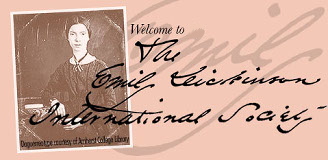
You are hereRamirez, Anne: "Emily Dickinson’s Momentous Mission: Messenger Between the Worlds"
Submitted by RFranz on July 18, 2013 - 5:12pm
Emily Dickinson’s Momentous Mission: Messenger Between the WorldsAnne Ramirez, Neumann University Emily Dickinson’s role as “World Citizen” can be examined through many lenses, but one interesting perspective is through her own use of the word “world” and related imagery within her poems and letters. In numerous instances, Dickinson employs “world” in reference to the temporal world and the world to come, rather than in a spatial or geographical context. The possibility, difficulty, or methods of travel or communication between this life and the next (or between past, present, and future on a smaller scale) are among her lifelong preoccupations. The late poem “Cosmopolites without a plea” (Fr 1592) can plausibly be interpreted as one of many presenting her own artistic creations as missives of good news to recipients in faraway lands or times. Other relevant images include the bird who brings messages from a far country or who is preparing to fly away, the books that magically transport us “lands away,” or the wanderer who looks forward to arriving at a distant home that may paradoxically be nearer than it appears. For this poet whose physical travels were comparatively limited, “much” seems “fairer for the farness—and for the foreignhood” ( #883), and much is enhanced by anticipating that which cannot yet be fully perceived. Dickinson looks forward to a future where those she cannot see will read her messages from Nature and her transcription of music from Paradise. To return to spatial metaphor for an intriguing example, the speaker of Robert Frost’s “After Apple-Picking” describes an orchard uncannily like that imagined in Dickinson’s #467, “A solemn thing within the soul.” Both poets invite readers to recognize themselves as temporarily dwelling in a place of autumnal beauty, from which their removal to another world is imminent. If Frost wrote his poem without having read Dickinson’s, their similarity only becomes the more remarkable.
|